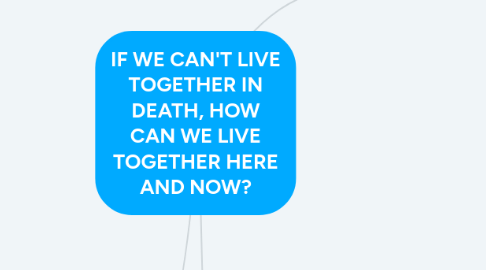
1. Stereotypes as a steppingstone to create more tolerance
1.1. "What are the differences?"
1.1.1. Stereotypes = dealing with small parts of reality = further from reality
1.1.1.1. Negative connotation
1.1.2. Prejudices = not dealing with small parts of reality = closer to reality
1.2. Stereotypes can help us defining how we are AND who we are. Prejudices not.
1.3. Identity
1.3.1. Different patches NOTE: all those patches (and stereotypes) are a steppingstone to understand (other) cultures.
1.3.1.1. Age
1.3.1.2. Gender
1.3.1.3. Ideals
1.3.1.4. ...
1.4. The cultural onion
1.4.1. Values
1.4.2. Symbols
2. Rites of passage
2.1. We all have them
2.1.1. White - black - yellow
2.1.1.1. Similarities? Diversity?
2.2. 4 rites of passage. Even if you don't believe, we all go through this 4 rituals.
2.2.1. Birth
2.2.1.1. Islam
2.2.1.1.1. Receiving a lot of visitors because of curiosity and ofcourse to share their hapiness with the new parents.
2.2.1.1.2. About a week after the birth, it's recommended to shave the newborn's head.
2.2.1.1.3. The main ritual is to give the newborn the 'Tahniek' = to place something sweet (like dates or honey) in the mouth of the newborn. And ofcouse making a lot of pleases (smeekbeden).
2.2.1.2. Catholicism
2.2.1.2.1. Catholics are baptized. We can say that the Jewish culture is the closest to the Catholics regard the birth.
2.2.1.2.2. Orthodox Catholics also baptize their newborn. But the only difference with Catholics, is that they put the whole body in water. Catholics only wet the forehead.
2.2.1.3. Non-believers
2.2.1.3.1. These people create their own ritual. Despite they are not religious, they do something at the birth of their child.
2.2.1.4. Baby carring
2.2.1.4.1. There are so many ways to carry your child. We are not used to this in Belgium, although it is almost a hype! Some ways are universal...
2.2.2. Puberty
2.2.2.1. Puberty rituals happen at an age of 12 years. Why? At that age the body changes.
2.2.2.1.1. Girls get their menstruation at that age. In some countries it means they're ready to marry. This is also true for boys. Who wins during a fight on that age increases its chance of getting married
2.2.2.1.2. Islam and Orthodox-Catholicism
2.2.2.1.3. Catholicism
2.2.2.1.4. Non-believers
2.2.3. Marriage
2.2.3.1. Visibility is important. People can see that you're married, so occupied. It is a must to show it to the world.
2.2.3.1.1. The most common symbol is a ring: Islam, Catholicism, even non-believers, etc.
2.2.3.1.2. In countries like New Guinea its visible by looking at the clothes. Women who wear skirts of straw that dangling are still not married.
2.2.4. Death
2.2.4.1. It's something universal to symbolize important rituals. Like death.
2.2.4.1.1. In China they symbolize death by the colour white. A white symbole with strings that indicate the age of the deceased.
2.2.4.1.2. - In Japan they symbolize something different. I'm talking about the graves. If you worked at a coffee company, your grave will symbolize that. But they have sooo many different graves. - A typical thing they do when they enter the cementery is washing the buddha's. - When kids die, they get the blame on theirselfs. They put a statue on the graves to protect them and so that spirits stay away.
2.2.4.2. Talking about universal. They're two ways for a decease. Either you will be buried or cremated.
2.2.4.2.1. In India, for example cremations do happen on the street for those who are really poor...
2.2.4.2.2. It's all a matter of money and space.
2.2.4.3. Islam
2.2.4.3.1. At the deathbed of a person, the family says the shahada. Before a deceased is buried, he is washed and wrapped in a shroud ritual. The men are praying along with an Imam. Only the men are carrying the coffin to the cementery. Woman are not allowed. The deceased should be buried with his head in the direction of Mecca. Since the Muslims believe in the last day they should not be cremated.
2.2.4.4. Fact: Jews ans Muslims fly over to their country to be burried. Why? Alternative graves are not allowed in Belgium. Another fact: Imams are looking for a solutions
3. Mourningrituals
3.1. "Death and mourning rituals"
3.1.1. All over the world there are symbols that indicate death. This can be a death card or merely another symbol
3.1.1.1. 1 The presence of death
3.1.1.2. 2 Seclusion and death
3.1.1.3. 3 The greatness of the death
3.1.1.3.1. Different types of graves around the world
3.1.1.4. 4 Life and death
3.1.1.5. 5 Wealth/poverty and death
3.1.1.6. 6 Traditions or diversity and death
3.1.1.7. 7 Variety in death
3.1.1.8. 8 The body and the death
3.1.1.9. 9 Color of death
3.1.1.10. 10 Geography and death
3.1.1.11. 11 Debt and death
3.1.1.12. 12 Colonialism and death
3.1.1.13. 13 Bad spirit and death
3.1.2. There are different opinions about death and what comes after
3.1.2.1. Life after death. heaven. We go to the stars. There is no evidence of heaven... Reincarnation. Wheel of life.
